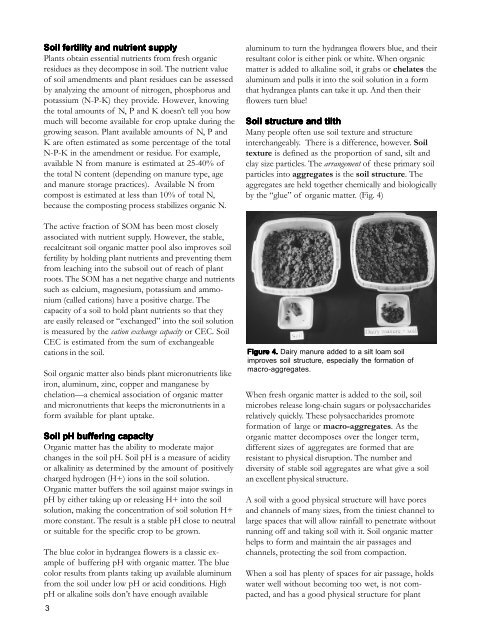Building Soil Organic Matter with Organic Amendments - Center for ...
Building Soil Organic Matter with Organic Amendments - Center for ...
Building Soil Organic Matter with Organic Amendments - Center for ...
You also want an ePaper? Increase the reach of your titles
YUMPU automatically turns print PDFs into web optimized ePapers that Google loves.
<strong>Soil</strong> fertility and nutrient supplyPlants obtain essential nutrients from fresh organicresidues as they decompose in soil. The nutrient valueof soil amendments and plant residues can be assessedby analyzing the amount of nitrogen, phosphorus andpotassium (N-P-K) they provide. However, knowingthe total amounts of N, P and K doesn’t tell you howmuch will become available <strong>for</strong> crop uptake during thegrowing season. Plant available amounts of N, P andK are often estimated as some percentage of the totalN-P-K in the amendment or residue. For example,available N from manure is estimated at 25-40% ofthe total N content (depending on manure type, ageand manure storage practices). Available N fromcompost is estimated at less than 10% of total N,because the composting process stabilizes organic N.The active fraction of SOM has been most closelyassociated <strong>with</strong> nutrient supply. However, the stable,recalcitrant soil organic matter pool also improves soilfertility by holding plant nutrients and preventing themfrom leaching into the subsoil out of reach of plantroots. The SOM has a net negative charge and nutrientssuch as calcium, magnesium, potassium and ammonium(called cations) have a positive charge. Thecapacity of a soil to hold plant nutrients so that theyare easily released or “exchanged” into the soil solutionis measured by the cation exchange capacity or CEC. <strong>Soil</strong>CEC is estimated from the sum of exchangeablecations in the soil.<strong>Soil</strong> organic matter also binds plant micronutrients likeiron, aluminum, zinc, copper and manganese bychelation—a chemical association of organic matterand micronutrients that keeps the micronutrients in a<strong>for</strong>m available <strong>for</strong> plant uptake.<strong>Soil</strong> pH buffering capacity<strong>Organic</strong> matter has the ability to moderate majorchanges in the soil pH. <strong>Soil</strong> pH is a measure of acidityor alkalinity as determined by the amount of positivelycharged hydrogen (H+) ions in the soil solution.<strong>Organic</strong> matter buffers the soil against major swings inpH by either taking up or releasing H+ into the soilsolution, making the concentration of soil solution H+more constant. The result is a stable pH close to neutralor suitable <strong>for</strong> the specific crop to be grown.The blue color in hydrangea flowers is a classic exampleof buffering pH <strong>with</strong> organic matter. The bluecolor results from plants taking up available aluminumfrom the soil under low pH or acid conditions. HighpH or alkaline soils don’t have enough available3aluminum to turn the hydrangea flowers blue, and theirresultant color is either pink or white. When organicmatter is added to alkaline soil, it grabs or chelates thealuminum and pulls it into the soil solution in a <strong>for</strong>mthat hydrangea plants can take it up. And then theirflowers turn blue!<strong>Soil</strong> structure and tilthMany people often use soil texture and structureinterchangeably. There is a difference, however. <strong>Soil</strong>texture is defined as the proportion of sand, silt andclay size particles. The arrangement of these primary soilparticles into aggregates is the soil structure. Theaggregates are held together chemically and biologicallyby the “glue” of organic matter. (Fig. 4)Figure 4. Dairy manure added to a silt loam soilimproves soil structure, especially the <strong>for</strong>mation ofmacro-aggregates.When fresh organic matter is added to the soil, soilmicrobes release long-chain sugars or polysaccharidesrelatively quickly. These polysaccharides promote<strong>for</strong>mation of large or macro-aggregates. As theorganic matter decomposes over the longer term,different sizes of aggregates are <strong>for</strong>med that areresistant to physical disruption. The number anddiversity of stable soil aggregates are what give a soilan excellent physical structure.A soil <strong>with</strong> a good physical structure will have poresand channels of many sizes, from the tiniest channel tolarge spaces that will allow rainfall to penetrate <strong>with</strong>outrunning off and taking soil <strong>with</strong> it. <strong>Soil</strong> organic matterhelps to <strong>for</strong>m and maintain the air passages andchannels, protecting the soil from compaction.When a soil has plenty of spaces <strong>for</strong> air passage, holdswater well <strong>with</strong>out becoming too wet, is not compacted,and has a good physical structure <strong>for</strong> plant
















